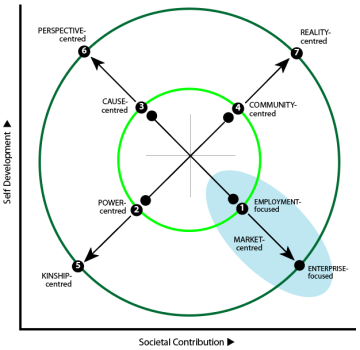New Frameworks Building on the Past
History of the Inquiry
The framework was developed in the early stages of this research project, indeed before frameworks were properly understood as part of a taxonomy.
More than 25 years later, that framework was identified with the formula : which means it is the within the .
The early investigations, stimulated by the theory of Clare Graves and its development as Spiral Dynamics, focused on the i.e. the Q-typology (then called a subsidiary typology).
That analysis using a Typology Essentials Table revealed numerous features of these approaches never previously identified.
However, the further investigations at that time which led to Spiral and Tree frameworks were all applications i.e. the TET axes names were adjusted to fit the particular application.![]() Details
Details
It is time now to come back to the unavoidable egotistical basics of personal functioning i.e. interacting within society so as to get the benefits you want—which results in «» and a diffuse sense of well-being.

Securing Prosperity
The TET layout of the ways we is shown at right. This diagram plots the 7 types of distinct and incompatible mentalities(mindsets or approaches) that a person tends to use over and over again in everyday interactions believing it will deliver benefits.
Each mentality taken in isolation feels suitable, satisfying, sufficient, and appropriate for whoever adopts them. The other mentalities, despite benefits experienced by others, are downplayed, rejected or even ridiculed.
However, a single mentality-type will not necessarily deliver, far less guarantee, prosperity or social statusin the sense of a secure and comfortable standard of living and respect from others.
Fortunately, it is possible to extract and combine values from each of these approaches that command general asset. It is in the nature of personal-social values that compatibility is inherent.
By combining values from all approaches, a person can go a long way to ensuring prosperity and establishing a position in society.
The focus on values (as distinct from methods) converts Types to Modes. In this case, the are renamed as . By progressively incorporating values from each mode, it is proposed that status can be systematically developed in Stages.
Frameworks
The frameworks follow a pattern that is now recognized as standard in the taxonomy:
-
Progressively securing prosperity over time is revealed via a Spiral () that develops in two Cycles.
-
The Spiral in turn produces a Tree pattern which reveals the .
-
The Tree leads into a structural hierarchy which reveals the components of .
-
The requirements in the structural hierarchy generate a further Tree revealing .
Start now:
- See the taxonomic path.
- See a preview of the trajectory for strengthening prosperity.
- Start analysis of the Spiral with Cycle-1
Originally posted: 20-Jun-2025